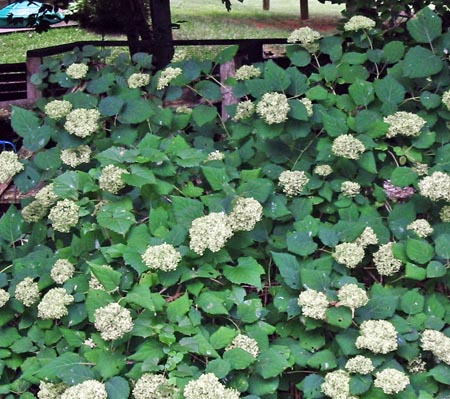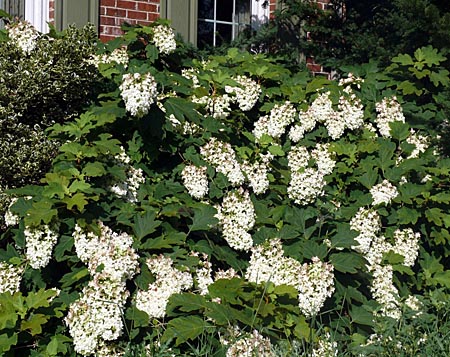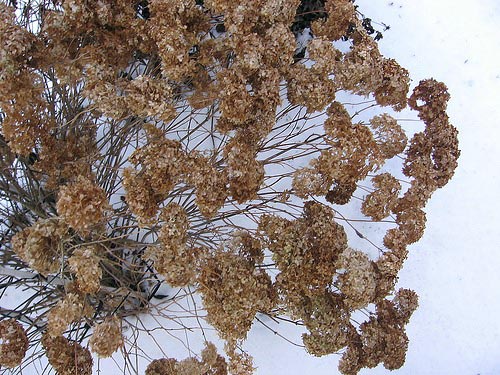Why You Have Few Hydrangea Blooms
by Elaine Homstad, Fairfax Master Gardener
Over the last several years, many local gardeners have wondered why their hydrangea bushes have not bloomed abundantly. The fault may well lie with heavy and late snows, as well as frigid temperatures, but hard winters are not the only reason hydrangeas lose some of their bloom power. The most common cause is attributed simply to human error. Hydrangeas, like most plants, thrive when you plant them in the right place and treat them kindly.
Location, location

Hydrangea arborescens ‘Annabelle’
Choosing the proper site is the single, most important factor in ensuring a hydrangea’s health and wellbeing. To help guide you, remember the acronym MESS, so your shrub doesn’t become one!
Moisture
The site should be one that is evenly moist, but not overly wet. Planting in a low-lying area that collects pools of water that do not drain quickly can cause a hydrangea’s roots and trunk to rot. In addition, during dry spells, water the hydrangea at its base, rather than from overhead, to prevent powdery mildew.
Exposure
Site hydrangeas where they have shelter from harsh winds or weather. Avoid northern or western exposures. Planting near a fence or wall can provide a windbreak and protection from severe weather. Just be sure the structure doesn’t block needed light.
Soil
Well-draining soil, enriched with organic material, provides the moisture and nutrients that hydrangeas need to thrive. Add compost to the soil when first planting, or periodically mix a layer into the top few inches of soil around the plant. If you want to use fertilizer, apply continuous-release 10-10-10 in the spring and again in the fall, following package directions.
Sunlight
No hydrangea will bloom in deep shade. Hydrangeas need sunlight to flower, but too much sun can reduce flowering and cause leaf scorch. The ideal site should receive good morning and early afternoon sunlight and partial-to-full afternoon shade. A southern or eastern exposure is ideal.
What type hydrangea?

Hydrangea quercifolia ‘Snow Queen’
There are many hydrangea varieties and what type you choose makes a difference in how you take care of it. The five major types are:
• Big Leaf (Macrophylla and Serrata)
These include both mophead and lacecap flower varieties, which bloom on old wood. Ever-blooming varieties bloom on both old and new wood.
• Smooth (or Snowball) Arborescens
Named for the very round shape of the flower heads, these plants bloom on new wood.
• PeeGee or PG (Paniculata Grandiflora)
These hydrangeas are the only ones that can be grown as a single-trunk “tree” form.
• Oak Leaf (Quercifolia)
The oak-leaf hydrangeas are the hardiest. Sited properly, they will dependably bloom even after the harshest winter. Their leaf shape resembles an oak leaf.
• Climbing (Anomala and Petiolaris)
The only true vining varieties, these hydrangeas climb by attaching small aerial roots along their stems to another surface.
Pruning

Hydrangea arborescens ‘Annabelle’
Old wood? New wood? Ever-bloomers? If you know what type of hydrangea you have, you can follow this time-tested advice on pruning:
Old Wood = Prune in summer
New Wood = Prune in fall and winter
Ever-bloomers = Prune anytime
However, the best approach is to plant your hydrangea in a spot that will accommodate its size and spread, rather than pruning it annually to make it fit a space that is too small. Not only does this technique keep your hydrangea happier, it saves you work. You need only prune to remove dead wood or spent flowers. Getting rid of spent flowers, however, is optional. Leaving them in place provides wonderful fall and winter interest in your landscape. If you do cut them, try bringing them indoors to create interesting arrangements.
 In early- to mid-March you should inspect your hydrangeas for new buds. Look for new, greenish-brown buds along the stems. You will begin to see these at some point below the spent flower heads. Make your pruning cut about an inch above the first live bud — or above a lower one, if you wish to reduce the plant’s size or change its shape.
In early- to mid-March you should inspect your hydrangeas for new buds. Look for new, greenish-brown buds along the stems. You will begin to see these at some point below the spent flower heads. Make your pruning cut about an inch above the first live bud — or above a lower one, if you wish to reduce the plant’s size or change its shape.
Prune out any branches that have no buds or have dead buds. These will never produce leaves or flowers.

Winter damage on ‘Endless Summer’ ever-blooming hydrangea
This photo shows an excellent example of the effect of severe cold and late-winter snows on an ‘Endless Summer’ ever-blooming hydrangea, a plant that blooms on both new and old wood. Its buds had already formed when frigid air and heavy ice hit them. Although the plant produced abundant foliage on its new growth, fewer than five flower heads formed over the 2014 season.
Those intensely cold winters and late-winter snowfalls mean fewer blooms for other hydrangea types as well. Old-wood hydrangeas will lose their late-summer and early-fall buds, and fresh buds on new-wood hydrangeas will also suffer when winter packs a brutal or late-season punch.
This past winter –- with only one significant snowstorm and no sustained periods of frigid temperatures – was kinder to hydrangea bushes. So, how does that affect the answer to “Will my hydrangeas bloom this year?” If you have given your hydrangeas the proper care and location, they will very likely reward you with the lush, vibrant blooms that make hydrangeas a favorite landscape plant.
Resources
Hydrangea Selection, Pruning and Care, Virginia Cooperative Extension
Hydrangeas for American Gardens, by Michael A. Dirr